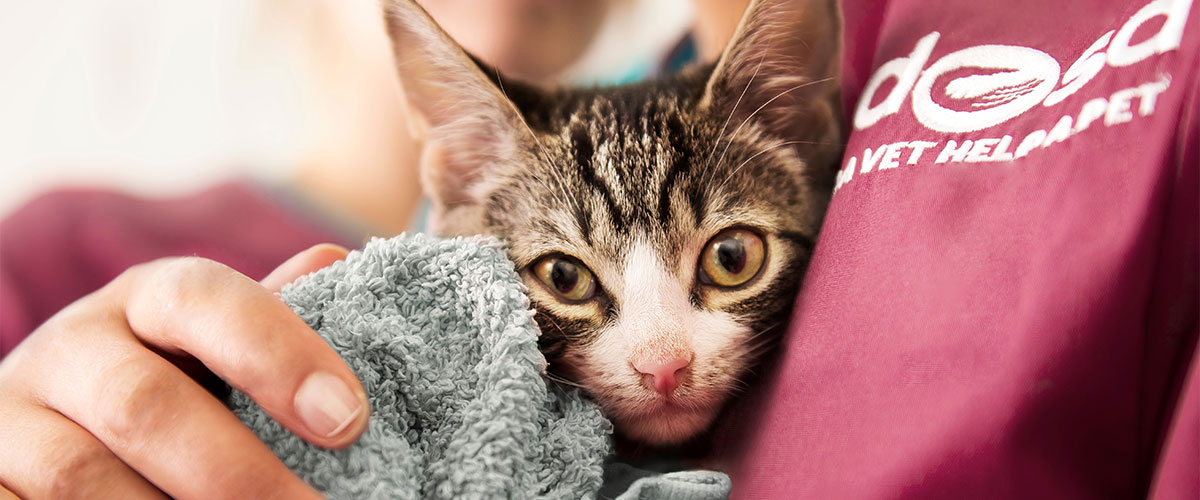Bladder infection (UTI) in cats
Overview
- A bladder infection (often called a UTI or cystitis), is a bacterial infection inside the bladder.
- Symptoms can include pain, difficulty peeing, peeing in strange places and blood-tinged urine.
- It is important to contact your vet as soon as you notice any symptoms of cystitis. UTI’s are painful and can cause very serious illness.
General information
A bladder infection (often called a UTI or cystitis), is a bacterial infection inside the bladder. Bladder infections are usually occur if there is another medical problem present affecting the urinary tract (i.e. bladder stones, diabetes, kidney disease, stress cystitis, or a bladder tumour). They rarely develop without an underlying cause and for this reason, if your cat develops a UTI your vet will check for other problems as well.
Symptoms of cystitis in cats
Symptoms of a bladder infection often include:
- Pain and straining to pee
- Blood in urine
- Peeing more often
- Peein very small amounts
- Peeing in strange places such as the bath, sink, bath matt or hard/cold floors
- Smelling of urine
- Excessive cleaning around their penis/vagina
- A wet patch or blood around their private parts.
When to contact your vet
Contact your vet as soon as you notice a change in your cat’s peeing habits, and if possible, take a urine sample to the appointment. Check out our video below on how to take a urine sample from your cat.
Without treatment, a UTI can lead to serious illness. Call your vet for an emergency appointment if your cat is trying to pee but not passing any urine. Being unable to pee can indicate a blocked bladder, which is a life threatening condition.
 Video found at youtu.be/rZmoiLXfDNY
Video found at youtu.be/rZmoiLXfDNY
Treatment
Treatment given for a UTI depends on its cause, but is likely to include:
- Pain relief. Anti-inflammatory pain relief (NSAID) is excellent at soothing bladder pain and inflammation.
- Bladder supplements. Bladder supplements are designed to soothe the lining of the bladder, although, there is no solid evidence to prove that they work.
- Antibiotics. A short course of antibiotics is usually an effective cure for a UTI. It’s very important to follow your vet’s instructions and complete the full course. If you stop your cat’s antibiotics early, it could mean some of the remaining strongest remaining bacteria survive and a more severe infection will develop.
Watch our video on how to give your cat a tablet:
 Video found at youtu.be/D-R383L64LI
Video found at youtu.be/D-R383L64LI
Outlook
Bladder infections/UTI’s usually clear up within a few days of starting treatment. If the infection returns, your vet may suggest further investigations to find out what’s causing the problem. Investigations may include urine tests, x-rays, blood tests, an ultrasound scan or even surgery to look inside the bladder. Any underlying conditions will need treatment to ensure infections don’t keep returning.
Preventing bacterial cystitis
There isn’t anything you can do to specifically prevent a bladder infection. However, the tips below will help you keep your cat’s bladder as healthy as possible.
- Encourage your cat to drink. Encourage your cat to drink lots of water to keep their kidneys and bladder healthy. Some cats like fresh water, others prefer stale water, and many cats love running water and water fountains. If your cat doesn’t like drinking, feed them wet food to increase their water intake.
- Weight. Overweight cats are at a higher risk of cystitis. Keep your cat a healthy weight and make sure they get enough exercise.
- Reduce stress. Stress can cause inflammation of the bladder lining, which can lead to infections. Ensure your cat’s life is as stress-free as possible.
Published: February 2020
Did you find this page useful?
Tell us more
Please note, our vets and nurses are unable to respond to questions via this form. If you are concerned about your pet’s health, please contact your vet directly.
Thank you for your feedback
Want to hear more about PDSA and get pet care tips from our vet experts?
Sign up to our e-newsletter
Written by vets and vet nurses. This advice is for UK pets only. Illustrations by Samantha Elmhurst.

